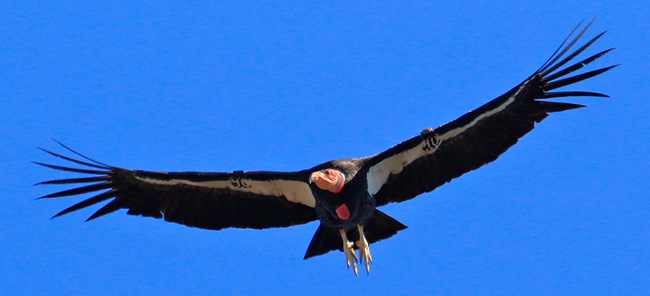Last updated: December 14, 2020
Article
Soon Condors Will Soar Over Redwoods

NPS Photo
With a nine and a half foot wingspan—the largest of any North American land bird—condors can travel over a hundred miles each day in search of food. These prehistoric-looking scavengers can easily tear into carcasses too large for others, but will gladly consume any carrion they come across. Despite their impressive size, condors are not hunters, and cannot kill prey themselves.
Condors began disappearing as Westward Expansion—beginning in the 1800s—altered their habitat, replacing wide-open spaces with increased disturbance. As new settlers killed bears and mountain lions, it reduced the number of large predators that provided condors with prey to scavenge. The carcasses that homesteaders left behind were often filled with toxic lead fragments from bullets, and poisoning campaigns killed condors who came to clean up the dead “nuisance” wildlife. Within a century, condors had declined to a tiny population in Southern California, and by 1987 they were extinct in the wild.
Only 27 condors remained in the world— all living in zoos —when a captive breeding program began. In the span of three decades, it has dramatically increased condor numbers, and they have now been successfully reintroduced to the wild in California’s Central Coast, as well as to the Arizona/Utah border and Baja California, Mexico —which are all part of the condors’ original range.
Now after years of work by dedicated conservationists, in the next year or two Redwood National and State Parks will be the release site for another condor reintroduction. This effort has been led by the Yurok Tribe working with numerous partners—including the National Park Service, California State Parks, Oregon Zoo, US Fish and Wildlife Service, US Forest Service, Ventana Wildlife Society, and Pacific Gas and Electric—to prepare for this historic step in condor recovery.
Indigenous peoples along the Pacific Coast had lived with condors since time immemorial. For many, like the Yurok, the condor is a fundamental part of their culture and traditions. Yurok wildlife biologists have spent years doing fieldwork to demonstrate the feasibility of reintroducing condors to their homeland. They believe that the return of the condor will also restore spiritual balance to their world. Redwood National and State Parks is proud to be part of the partnership that will return this critically endangered species to another part of its ancestral territory.
Many people think of national and state parks as places that protect ”pristine” nature, but Redwood National and State Parks demonstrates that parks can also repair and restore damaged ecosystems—ranging from thousands of acres of clearcut forest and sediment-laden streams resulting from over a century of logging to tramped vegetation and exposed roots caused by increased off-trail use by hikers. Condor reintroduction is another piece of this restoration puzzle whose benefits extend far beyond the parks’ boundaries.
[Article written by Sarah Brimeyer: Redwood National Park. First published in "Redwood National and State Parks Visitor Guide" 2020 Edition]
